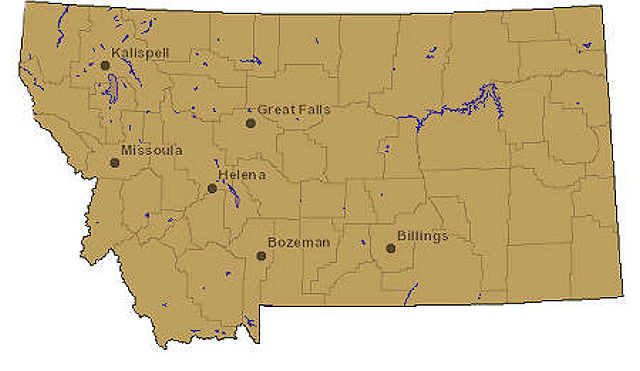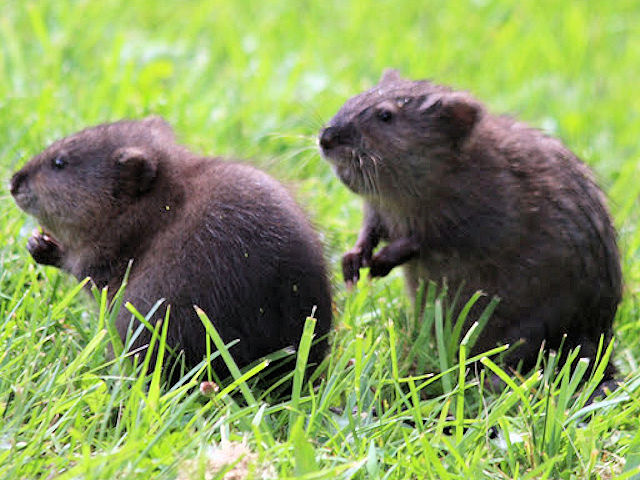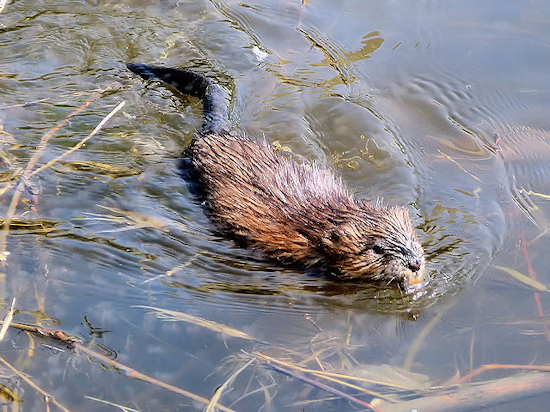Total length: 16 to 26 inches. Weight: 2 to 4 pounds.
Habitat: The most widespread of North American microtine (a subfamily of mice) rodents. Marshes, edges of ponds, lakes, streams, cattails, and rushes are typical habitats. An essential habitat ingredient is water of sufficient depth or velocity to prevent freezing. The presence of herbaceous vegetation, both aquatic and terrestrial, is another essential ingredient. In general, has very flexible habitat requirements and often coexists in habitats used by beavers.
Food Habits: Primarily herbivorous and will eat virtually any vegetable matter. Utilizes shoots, roots, bulbs, and leaves of aquatic plants. Cattails and bulrush are preferred foods. Will also consume cultivated crops. On occasion will eat animal matter. Food is stored in the burrow or den and during winter may even eat part of its own lodge.
Life History: May be thought of as an overgrown subaquatic vole. Mostly active at night but daytime activity is not unusual. Often builds conspicuous dome-shaped houses. Breeds during spring and summer. 5 or 6 young are born after a 22 to 30 gestation. May have two or three litters per year.
Similar Species: Beaver - has large dorsally flattened scale over tail.
The muskrat is a common and valuable furbearer. Muskrats are widely distributed throughout North America. This species can adapt to a wide variety of climates. Muskrats are dependent upon habitats including water. This species thrives in many lakes, rivers, creeks, ponds, and marshes. Muskrats can tolerate a certain amount of pollution in water, and this important furbearer is often found living within large cities.
 Description
Description
The muskrat is classified as a rodent because of
its four incisor teeth in the front of the
mouth. The two upper and two lower incisors
overlap, allowing them to self-sharpen as they
are used. Folds of skin behind the incisors
allow a submerged muskrat to cut vegetation
without getting water into its mouth. The size
and weight of muskrats varies with regions, and
the quality of food available. Southern muskrats
average around two pounds in weight, and weights
of three and four pounds are common for muskrats
in the Northern states. Most adult muskrats
attain a length of 22-25 inches, including the
nearly hairless tail.
The muskrat has relatively small front feet, with four major toes and small thumbs. Hind feet are much larger, and partially webbed. The tail of a muskrat is deeper than it is wide, and it tapers to a blunt point at the end. The species use their tails as an aid to swimming.
Muskrat fur is short and dense. Colors are mostly browns with lighter shades of greys or blondes on chest and stomach areas. The underfur traps air, and prevents the skin of the muskrat from becoming wet while it is in the water. Musk glands are predominant beneath the skin on the lower abdomen of male muskrats. These two glands become swollen during the spring and produce a yellowish, musky smelling fluid.
 Reproduction
Reproduction
Muskrats are one of our most prolific species.
Adult muskrats can have up to five litters in a
year's time. Muskrats in northern states seem to
average about 2.5 litters a year. Muskrats in
southern states often average 3 litters. Litter
sizes vary, and 5 or 6 kits per litter is
common. There is evidence that muskrat
populations may be somewhat cyclic. Muskrats
produce fewer litters when populations are dense
and more litters when populations are sparse.
The quality and abundance of food also affects
the number of litters as well as litter sizes.
Female muskrats born in the spring are sometimes capable of raising their own litter by late summer or early autumn. An average female muskrat will raise about 15 or 16 young in a good year. One female muskrat has been known to produce 46 young in one year. The gestation period for muskrats is 29 days. Muskrats are thought to have one mate during rearing seasons.
Habits
Muskrats are somewhat sociable with others of
the same species, but will often fight to the
death as populations become dense. Preferred
foods include a variety of vegetation, including
roots, stems, and buds. Muskrats often seek out
undercut banks for protection while feeding.
Food is usually carried by this furbearer by
mouth, and eating takes place above the water
level. Muskrats are often active during the day,
as well as night, with peak activities near dawn
and dusk. Muskrats commonly stay underwater for
five minutes while searching for food and they
are capable of holding their breath underwater
for 10-12 minutes. Territory sizes vary
according to population densities and the
quality of the habitat. These territories
average about 200 feet in diameter in marsh
habitats, and slightly longer along streams.
Dispersals occur when the young are encouraged
to leave the dens. Most of the young muskrats do
not move further away than 200 feet in good
habitats. Adult muskrats sometimes disburse
further distances, particularly in the early
spring before mating season begins.
In many marshy areas muskrats build dome shaped lodges of vegetation in the water, similar to beaver lodges, but smaller in size, these lodges have one or more underwater entrances, and commonly house an entire family group. Smaller but similar structures are known as "push-ups". These push-ups usually serve a muskrat as a protected feeding and resting area, especially after ice forms on the water surface. Bank dens are common and these usually have underwater entrances leading upwards to hollowed out chambers in the bank above the waterline. Trails of air bubbles can often be seen through thin ice. These bubble trails are made by muskrats exhaling air as they swim beneath the frozen surface.
General
Uncontrolled muskrat populations do cause damage
to private property and habitat. Hole digging
activities undermine earthen dams and dikes.
Damages also occur to irrigation canals and farm
ponds. Large populations of muskrats also cause
"eat-outs". These areas are simply overcropped
by the feeding activities of the muskrats and
the loss of vegetation and resulting silting
makes the area less productive for other
wildlife species as well. Muskrat "eat-outs"
often destroy the roots of the vegetation, and
it may take 15-20 years for the habitat to
return to its original capacity to serve
wildlife.
Muskrats are an important prey for a variety of wildlife, including mink, fox, coyotes, hawks and owls.
One major disease is Errington's disease. This serious virus can live in mud and infect muskrats in areas that have been uninhabited by other muskrats for as long as 5 years. Epidemics can and do occur with this devastating disease. Muskrats are also vulnerable to tularemia, and a variety of internal and external parasites.
Few muskrats attain four years of age.




